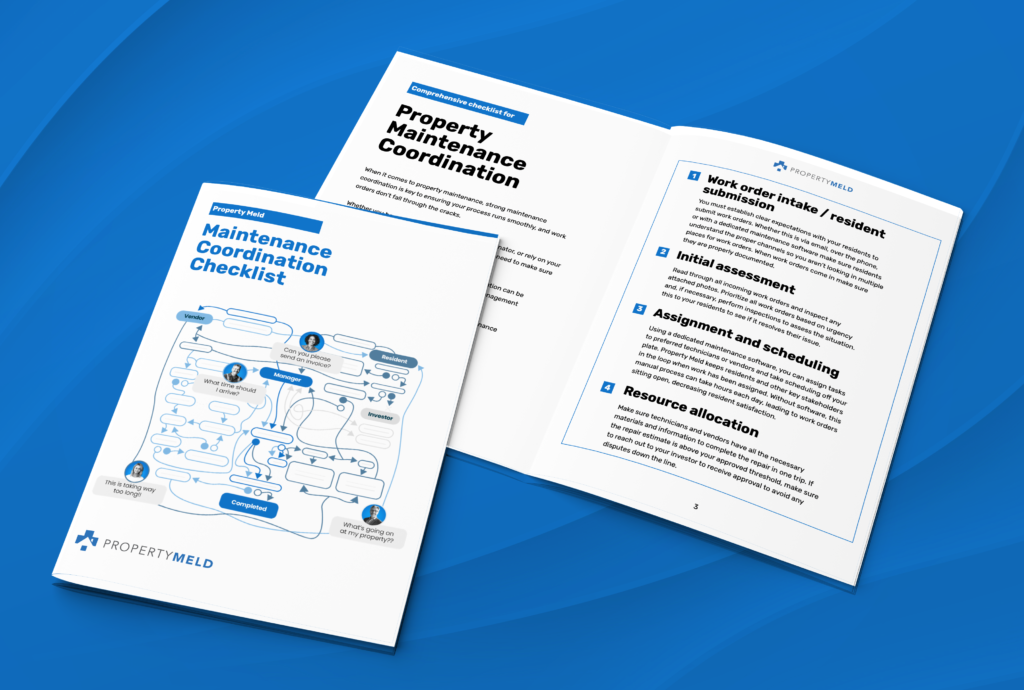What does your traditional maintenance process look like this time of year? Are you manually scheduling maintenance requests and assuming your residents and vendors communicate efficiently? Is this how you’ve always done it? We’ll bear with you, it’s hard to break the cycle. That’s why we created this maintenance checklist — to help you manually keep track of your property management maintenance process one request at a time. But did you know there is a better way?
Download our comprehensive property maintenance coordination checklist to ensure work orders don’t fall through the cracks.
Property Maintenance Coordination Checklist
1. Work Order Intake and Documentation
– Receive Work Orders: Ensure all work orders are received through designated channels (e.g., email, maintenance software, phone).- Document Details: Record all relevant details such as the requester’s name, contact information, property address, issue description, and date of request.
– Assign Work Order ID: Assign a unique identification number to each work order for tracking purposes.
2. Initial Assessment
– Prioritize Work Orders: Evaluate the urgency of each request and categorize them (e.g., emergency, high, medium, low priority).
– Site Inspection (if needed): Conduct an initial site inspection to assess the situation and determine the resources required.
3. Planning and Scheduling
– Assign Technicians: Assign the work order to the appropriate technician or contractor based on skill set and availability.
– Schedule Work: Set a timeline for the completion of the work order and communicate the schedule to all involved parties.
4. Resource Allocation
– Procure Materials: Ensure all necessary materials, tools, and equipment are available or ordered in advance.
– Budgeting: Allocate budget for the work order and get necessary approvals if required.
5. Execution and Monitoring
– Track Progress: Monitor the status of each work order regularly and update the status in the maintenance system.
– Communicate Updates: Keep the requester informed about the progress, any delays, or issues encountered.
6. Quality Control
– Inspect Completed Work: Conduct a post-completion inspection to ensure the work has been done to the required standard.
– Obtain Sign-off: Get a sign-off from the requester or property manager confirming the job is satisfactorily completed.
7. Documentation and Record Keeping
– Update Records: Ensure all details related to the completed work order are recorded in the maintenance system.
– Store Documentation: Keep copies of invoices, receipts, and any other relevant documents.
8. Feedback and Follow-Up
– Request Feedback: Ask the requester for feedback on the quality of service and the resolution of the issue.
– Address Complaints: If there are any complaints or issues, address them promptly.
9. Review and Analysis
– Analyze Data: Regularly analyze work order data to identify trends, recurring issues, and areas for improvement.
– Report Findings: Generate reports for management review and suggest improvements based on findings.
10. Continuous Improvement
– Training: Provide ongoing training for maintenance staff to improve skills and efficiency.
– Process Improvement: Continuously evaluate and improve the work order management process to enhance service quality and efficiency.
By following this checklist, you can ensure a structured and efficient approach to property maintenance coordination, leading to timely and satisfactory resolution of work orders. But as you can see, this list is fairly exhaustive, and this is just for one work order! Property management companies managing 500 units can expect at least 200 work orders each month.
But don’t worry, there is a better way to coordinate maintenance than relying on manual process, spreadsheets, and checklists.
Could you use intelligent property maintenance instead?
If a streamlined maintenance process has your attention, we’re happy to help! When you’re managing hundreds of units, an efficient maintenance operation can be out of reach. We continue to analyze millions of service issues to learn how to craft the most efficient maintenance process possible. With our software, you can streamline all communication for your key players, including residents (tenants), vendors, technicians, and owners. According to our data, property management companies using our solution spend 60% less time on coordinating maintenance — it works for them, and it will work for you. Let us show you how intelligent maintenance can save you time, money, and the headache of manually scheduling maintenance requests. It’s time for something better. It’s time to Meld.





